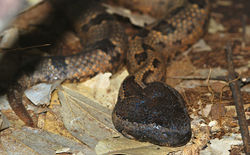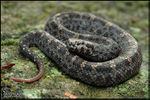Chinese mountain pit viper
| Chinese mountain pit viper |
|---|

|
| Scientific Classification |
|
| Scientific Name |
|
Ovophis monticolla |
| Ovophis Monticolla located on the forest somewhere in Asia |
The Chinese Mountain Pit Viper is a dangerous snake that mostly lives in Asia. The scientific name for this species is Ovophis Monticolla. This snakes has a stout body and a short snout, with its head covered by large shields. The shape of the head looks like a shape of triangle.[1] The Chinese mountain pit viper is a snake that is venomous, and are usually found to reside in mountainous rocky areas. They also prefer moist conditions. This snakes mostly occur in big country in Asia like China, Thailand, Indonesia, and some other countries. This nocturnal species is active at dawn and dusk, and are usually encountered in rock crevices or piles of logs.[2]
The Chinese Mountain Pit Viper is sexual dimorphism where the characteristics between the female and male species are different beyond their sexual organs.[3] One thing that makes this species interesting is when the mother gives birth, she will aggressively protects the eggs until the babies come out, and another thing that people rarely know is that the female can actually lay up to 27 eggs that hatch in about 50 days. Nevertheless, this species can eat anything they want, especially when they are really hungry, there is a chance that this snakes can eat human.[4]
Body Design
The Chinese Mountain Pit Viper (Ovophis monticola) has a stout body and a short snout, with its head covered by large shields. Its scales are usually soft having 23-25 rows longitudinally. It supraoculars scales (scales on the crown which is located immediately above the eye) consist of 5-9 scales in a line between the eyes. [5]
The Chinese Mountain Pit viper is a really big snake which the whole body length is 49 cm for males, and 110 cm for females. Nevertheless, the tail is one of the body part that makes this species huge and long. The tail length for the males is 8 cm and then 15 cm for the females. [6] Therefore, even though these species is huge, doesn't mean that they are weak and can't do anything, they are actually strong and its actually very hazardous. These species has a very dangerous attacking move especially with their tongue which has a lot of poison and it could be a fatality when someone gets bite by this snake. [7]
Life Cycle
The Chinese Mountain pit viper is a sexual dimorphism species in which this species is also listed as the largest and hazardous snake in China. This species is able to eat anything, especially when they are super hungry, they can eat a human. The Chinese Mountain pit viper is a bit different with any other kind of vipers on the way they gave birth. This species gave birth by laying eggs and what makes it interesting is that the mother will not leave the eggs and will protect them until the baby snakes come out of the eggs. Therefore, there is another thing on how the mother gave birth, which this species has white tail tips that function to help them lure prey. Nevertheless, the Chinese Mountain pit viper has one thing that people rarely know which is that the female can actually lay up to 27 eggs that crack open in about 50 days.[8]
This Chinese Mountain pit viper can eat really fast, and it is very dangerous to be close to this species because of the bite. This snake is very aggressive when they have nothing to eat. If people got bitten by this snakes, it could be really painful, swell, bleeding, and may cause a huge surprised/shocked.[9]
Ecology
The Chinese mountain pit viper is a snake that is venomous (species that are capable to produce venom) which are usually found to reside in mountainous rocky areas and they also prefer moist condition.[10] They mostly occur in Asia which is Nepal, northeastern India, Myanmar, Northern Thailand, Southern Laos, Southwestern China, and Northern and Central Vietnam. This nocturnal species is active at dawn and dusk, and is usually encountered in rock crevices or piles of logs. The Chinese Mountain Pit Viper's habitat are wet subtropical forests. Some of these snake are inactive which means they usually prefer more to stay in one place and ambush their prey. [11]
Therefore, the Ovophis monticola exhibits sexual dimorphism where the characteristics between the female and male species are different beyond their sexual organs.[12]
Food
The Chinese Mountain Pit Viper eats a lot of things. They can probably eat anything including human when they are really hungry and haven't eaten for a while. Some of these snakes are actually inactive which they will always be in one area, that is why they are a big eater. [13] The Ovophis Monticola usually eats rats, but rats are not the only food for them. These snakes can eat any other kind of species including, small mammals, lizards, insectivores, rodents, and even birds. This species is one of the hazardous pit viper among all and it is also the largest. What makes them huge is because of what they eat. The Ovophis Monticola will performed really aggressive when they see/find any kind of food. These snakes hiss loudly and strike very quick. The Chinese Mountain pit viper doesn't eat everyday, its like other snakes, but this snakes eats and digests pretty quickly. [14]
Video
Ovophis Monticola
References
- ↑ Ovophis monticola Mountain Pitviper Web. Last accessed January 3, 2017. Author Unknown.
- ↑ Ovophis monticola Last accessed December 25, 2016. Author Unknown
- ↑ Ovophis monticola Mountain Pitviper Web. Last accessed December 25, 2016. Author Unknown.
- ↑ Chinese mountain viper Web. Last accessed January 18, 2017. Author Unknown
- ↑ Ovophis monticola Mountain Pitviper Web. Last accessed January 3, 2017. Author Unknown.
- ↑ Ovophis monticola Lutz, Mario. Web. Last accessed December 28, 2016.
- ↑ Ovophis monticola venom Web. Last accessed January 4, 2017.Author Unknown.
- ↑ Chinese mountain viper Web. Last accessed January 18, 2017.Author Unknown.
- ↑ Chinese mountain viper Web. Last edited July 22, 2011.Author Unknown.
- ↑ Ovophis monticola Web. Last accessed December 25, 2016. Author Unknown.
- ↑ Chinese mountain viper Web. Last accessed January 18, 2017. Author Unknown.
- ↑ Ovophis monticola Mountain Pitviper Web. Last accessed December 25, 2016. Author Unknown.
- ↑ Chinese Mountain Viper Web. Last accessed Janyary 18, 2017. Author Unknown.
- ↑ Mountain Pitviper Web. Last edited July 22, 2011. Author Unknown.



